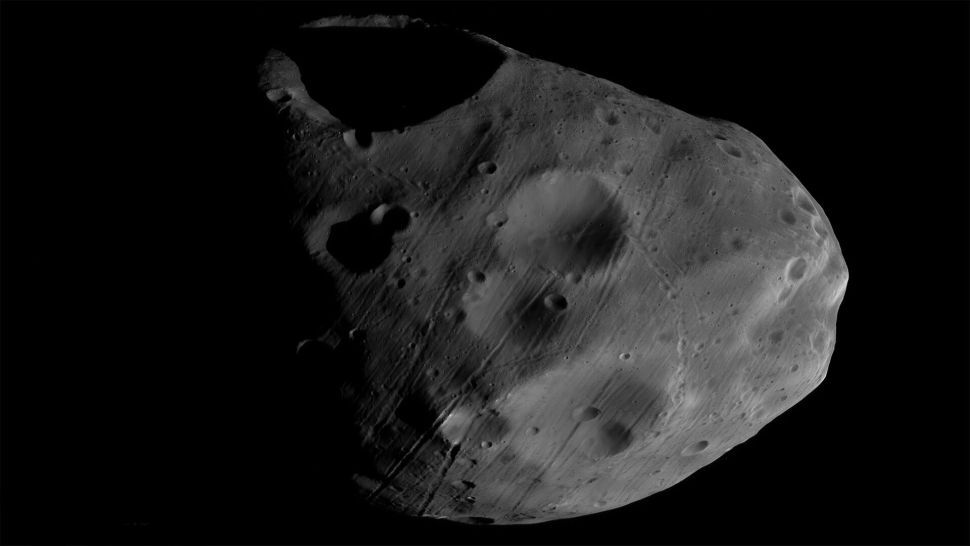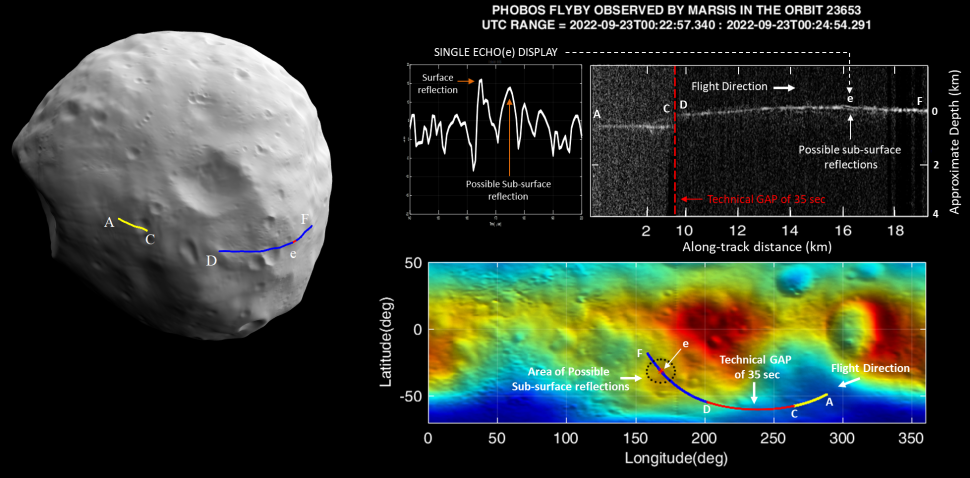2.11.2022
Understanding the interior structure of Phobos could be key in solving the mystery of its origin.

A close-up of the Martian moon Phobos. (Image credit: ESA/DLR/FU Berlin)
Europe's Mars Express spacecraft has peered deeper into the subsurface of the Martian moon Phobos than ever before, finding hints of unknown structures that could be clues as to the moon's origin.
Mars Express, which is a 19-year-veteran spacecraft in orbit around Mars, came within 51.6 miles (83 kilometers) of Phobos on Sept. 22, 2022 and was able to probe beneath the moon's surface using upgraded software on its MARSIS instrument (Mars Advanced Radar for Subsurface and Ionosphere Sounding).
Understanding the interior structure of Phobos could be key in solving the mystery of its origin. "We are still at an early stage in our analysis, but we have already seen possible signs of previously unknown features below the moon's surface," said Andrea Cicchetti, who is a member of the MARSIS science team at INAF, the Italian National Institute for Astrophysics, in a statement(opens in new tab).
Mars has two moons, named Phobos and Deimos after the gods of 'fear' and 'panic' in Greek mythology. Unlike the major moons of our solar system, Phobos and Deimos are tiny, just 16.7 miles (27 kilometers) and 9.3 miles (15 kilometers) across, respectively. They have a similar composition to carbonaceous C-type asteroids, and are irregularly shaped like asteroids too, which has led to the suspicion that they actually are rogue asteroids captured by Mars' gravity. However, both Phobos and Deimos' orbits around the red planet are over Mars' equator and both orbits are extremely circular, which suggests they formed around Mars. If they had been captured, they would be expected to have more elliptical orbits in different planes.
"Whether Mars' two small moons are captured asteroids or made of material ripped from Mars during a collision is an open question," said Colin Wilson, who is a scientist on the European Space Agency's Mars Express mission, in the same statement(opens in new tab).
MARSIS involves a 40-meter-long antenna beaming low frequency radio waves down to the surface. Most of the radio waves are reflected directly back from the surface, but some penetrate deeper, where they encounter transitions between layers of different composition and structure, and are reflected back by these boundaries. The stronger the reflection in the resulting 'radargram', the brighter the returning radio signal.
The radargram from across a narrow track on Phobos shows a bright line, split into two and labeled A–C and D–F respectively. The A–C section was captured using the old MARSIS software to compare with D–F, which utilizes the new software and which shows much more detail. The main bright line is the reflection from the surface of Phobos, but beneath that there is evidence for fainter lines that could just be interference, or 'clutter,' from features on the surface, but they could also be caused by structures below the surface.

A 'radargram' acquired by MARSIS during the flyby of Phobos on 23 September 2022. A radargram reveals the 'echoes' created when the radio signal emitted by MARSIS bounces off something and returns to the instrument. (Image credit: INAF - Istituto Nazionale di Astrofisica)
MARSIS had been designed to probe Mars' interior from an orbital distance of more than 155 miles (250 kilometers), but the recent software upgrade allows MARSIS to operate at much closer distances, permitting its use during close fly-bys of the moons.
Getting even closer to Phobos will provide radargrams with even greater resolution than that achieved here. The plan over the next few years is to employ MARSIS as close as 40 kilometers (24.9 miles) to Phobos.
"The orbit of Mars Express has been fine-tuned to get us as close to Phobos as possible during a handful of flybys between 2023 and 2025," said Cicchetti.
Mars Express isn't the only mission focused on Phobos. In September 2024, the Japanese Aerospace Exploration Agency (JAXA) plans to launch the Martian Moon eXploration (MMX) spacecraft. Much like JAXA's Hayabusa2 mission to retrieve samples from the near-Earth asteroid Ryugu, MMX will capture at minimum 10 grams of regolith from Phobos' surface. MMX will also deploy a small rover onto the surface, before venturing off to take a good look at Mars' second moon, Deimos, and then returning to Earth with the precious Phobos samples that will be analyzed in scientists' laboratories here on Earth.
Quelle: SC

